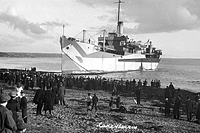EFC Design 1042 (Standard Lake "B"): Notes & Illustrations

Click here for a larger and more complete copy of this plan: Sheet 1.
Click on the photographs below to prompt larger views of the same images.
|
Notes: EFC Design 1042 (Standard Lake "B") was built by the EFC at the two Great Lakes Engineering Works (GLEW) yards at Ecorse (River Rouge, Detroit), Michigan, and Ashtabula, Ohio. Production of this design by the EFC was limited to six ships (four at Ecorse and two at Ashtabula) that were ordered on 5 March 1918 under Contract no. 200 at the same time that 24 ships of GLEW's "Stemwinder" Design 1060 were ordered under Contract no. 199. Previously the two GLEW yards had built 24 ships of essentially the same type as Design 1042 to orders from British and American interests (the first one was a Norwegian order), all of which were subsequently requisitioned. Even before that, Manitowoc built three ships like Design 1042 for the British that were also requisitioned. Construction of the design that became EFC Design 1042 began when Manitowoc laid down three ships for the British between January and August 1917. These ships had a rig that the British used in most of their UK-built standard ships consisting of pairs of derrick posts replacing the usual masts in the wells fore and aft and a light mast near the funnel, mainly for radio antennas. For its next order, two ships for a Norwegian buyer, Manitowoc shifted to a design similar to the Norwegian Fredrikstad type that became EFC Design 1044. The Great Lakes Engineering Works (GLEW) then took over the British-style design. Before World War I GLEW had specialized in large Great Lakes bulk carriers, but it had also built some Welland Canal size (under 260') salt-water cargo carriers of both the three-island and "Stemwinder" (cabins and engine room aft) types. After building four Stemwinders for foreign orders the firm laid down one ship of the three-island Manitowoc/British type in August 1917 for a Norwegian order and followed with the first of 17 ships for the British in September 1917. An order followed from an American firm for six more ships of the same type, which GLEW laid down in April and May 1918 after all 24 of its ships of this type along with the three Manitowoc ships had been requisitioned. The EFC made no major changes to this design when they adopted it as its Design 1042 (Standard Lake "B") and ordered six ships of that type on 5 March 1918. This order accompanied one for 24 Stemwinders, which had a larger deadweight capacity. The EFC may have placed its order for the smaller ships to use materials in the yard that had already been fabricated and close out that production line. They took a similar action on 28 March 1918 when they ordered a final six ships of Design 1020 along with 60 larger-capacity Design 1093 ships. (Special sources: The Great Lakes Engineering Works: The Shipyard and its Vessels, edited by Skip Meier and Wayne Garrett, The Marine Historical Society of Detroit, 2008, download at www.mhsd.org/publications; Lloyd's Register Foundation, hec.lrfoundation.org.uk/archive-library/documents/) Requisitioned Sisters: During 1916-1917 British, Norwegian, and American interests placed orders for 24 ships with the Great Lakes Engineering Works at its two yards at Ashtabula, Ohio, and Ecorse (River Rouge), Michigan, to a design that later became EFC Design 1042. All of these ships, Yard nos. 176-199, were requisitioned by the Shipping Board on 3 August 1917 and are covered in the Requisitioned Ships portion of the McKellar list. The British also ordered three ships to the same design at the Manitowoc Shipbuilding Co. (Yard nos. 82, 83, and 86), which were similarly requisitioned. Specifications: Design 1042 (S.S. Connersville, EFC Hull 1280): Steel Cargo. Deadweight tons: 3300 designed, 3364 actual. Dimensions: 261' length oa, 253.5' pp x 43.5' beam mld. x 22.5' depth mld., 19.8' draft loaded. Propulsion: 1 screw, 1 triple expansion engine, 2 Scotch boilers, 1250 IHP, 8.5 kts. Configuration: 3-island, 1 deck, 2 holds, 4 hatches. |

| S.S. Crawl Keys (Design 1042, EFC Hull 1284) on 15 August 1918, the date of her delivery to the Shipping Board's Division of Operations. This "Laker" was built by the Great Lakes Engineering Works, River Rouge Plant, Ecorse, Mich. This design features two pairs of derrick posts fore and aft and a single light mast near the stack. The sign under the bridge wing says "I am 29 days old. Look me over." (NARA: RG-32-M box 13) (Click photo to enlarge) |














